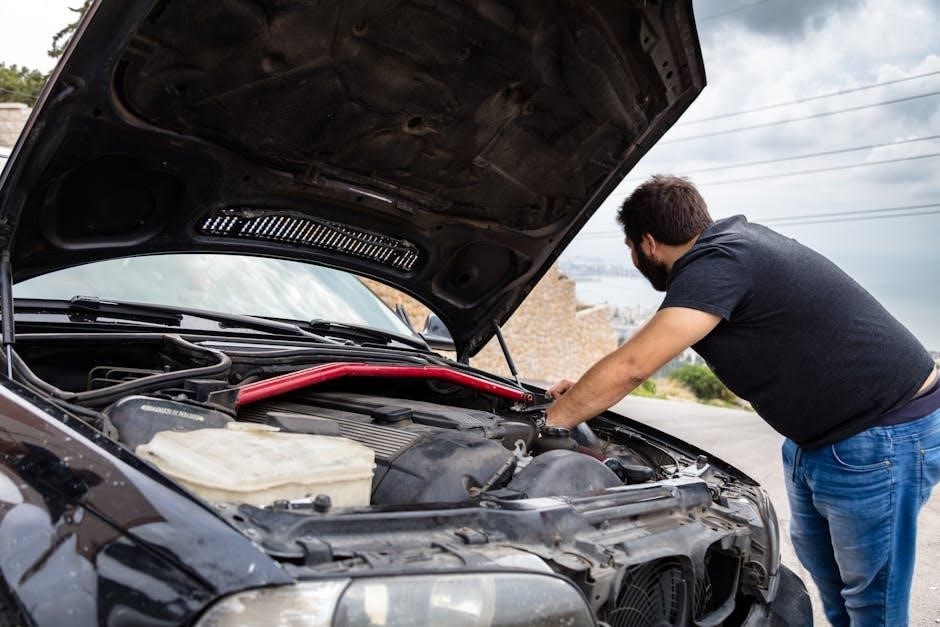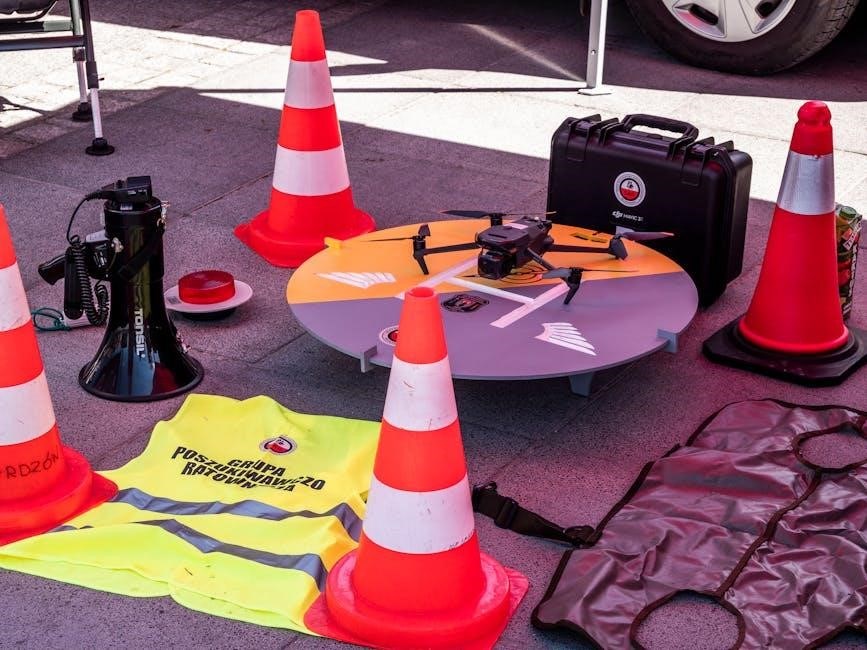A CDL Pre-Trip Inspection is crucial for ensuring safety and compliance. It helps drivers identify potential issues before starting a journey. PDF checklists are valuable tools for training and testing, covering all essential vehicle components from engine to trailer, ensuring a thorough evaluation for safe operation.
Purpose of a CDL Pre-Trip Inspection
The primary purpose of a CDL Pre-Trip Inspection is to ensure the vehicle is safe to operate and compliant with regulations. This inspection helps drivers identify potential mechanical issues before starting a journey, preventing breakdowns and accidents. It also serves as a legal requirement, demonstrating adherence to safety standards. By systematically checking components like brakes, tires, and lights, drivers can address defects early, reducing risks on the road. Additionally, this process fosters a culture of safety and accountability, protecting both the driver and other road users. A thorough pre-trip inspection is essential for maintaining a company’s reputation and ensuring the driver’s credentials remain valid. It is a critical step in preparing for a safe and efficient trip.
Steps Involved in the Inspection
The CDL Pre-Trip Inspection follows a structured process to ensure all critical components are evaluated. It begins with an exterior check, where drivers inspect the engine compartment for leaks, tires for proper inflation, brakes for functionality, and suspension for stability. The coupling system is examined to ensure secure connections between the tractor and trailer. Lights and signals are tested to confirm they are operational. Moving inside the vehicle, the dashboard and instruments are checked for accurate readings, the seat and seatbelt are adjusted for safety, and the steering and controls are tested for responsiveness. Mirrors are adjusted for optimal visibility, and additional equipment like fire extinguishers and first aid kits are verified. Each step is methodically performed to guarantee the vehicle is roadworthy and safe to operate.


Exterior Checks
Exterior checks involve inspecting the engine compartment, tires, wheels, brakes, suspension, coupling system, and lights. Each component is evaluated for safety and proper functionality before operation.
Engine Compartment
The engine compartment inspection ensures all vital systems are functional. Drivers check for leaks, ensure the truck isn’t leaning, and verify lights are operational. Proper fluid levels, including oil and coolant, are confirmed. The battery is inspected for charge and secure connections. Belts and hoses are examined for cracks or wear. The air filter is checked for cleanliness, and the horn is tested. These steps ensure the engine is in good working condition, preventing potential breakdowns and ensuring safety on the road. Regular checks help maintain efficiency and prevent costly repairs. A thorough engine compartment inspection is essential for a safe and successful trip.
Tires and Wheels
Tires and wheels are critical for vehicle stability and safety. During the inspection, check tire pressure using a gauge, ensuring it matches the manufacturer’s specifications. Inspect tread depth, looking for wear or uneven patterns. Check for signs of damage, such as cuts, bulges, or punctures. Verify that all lug nuts are tight and properly torqued. Ensure the wheels are free from damage or cracks. Also, inspect the rims for dents or rust. Proper tire inflation and condition are essential to prevent blowouts and maintain control. Additionally, check the spare tire and wheel to ensure they are ready for use if needed. This step ensures the vehicle can handle road conditions safely and efficiently, complying with regulations and preventing potential hazards.

Brakes

Brakes are a vital component of vehicle safety. During the pre-trip inspection, examine the brake system thoroughly. Check the brake chambers, push rods, and slack adjusters for proper alignment and function. Inspect air lines and hoses for leaks or damage. Ensure the brake drums and linings are in good condition, with no excessive wear. Verify that the brake shoes are properly adjusted and not dragging. Look for any signs of fluid leaks around the brake components. Test the service brakes by applying them to ensure they engage evenly and effectively. Also, check the emergency brake system to confirm it holds the vehicle securely. Properly functioning brakes are essential for safe operation, and any defects must be addressed before driving to prevent potential accidents and ensure compliance with regulations.

Suspension
The suspension system is critical for maintaining vehicle stability and supporting the weight of the truck and its load. During the pre-trip inspection, check the suspension components for damage or wear. Inspect the springs for cracks or breaks and ensure they are securely attached. Examine the U-bolts and spring hangers for proper tightness and alignment. Look for signs of rust or excessive wear. Check the shock absorbers for leaks or damage and ensure they are functioning correctly. Verify that the suspension is not sagging or misaligned, as this can affect handling. Ensure all suspension parts are in good condition, as any failure can lead to loss of control or structural issues. A thorough inspection helps prevent potential hazards and ensures a safe driving experience.

Coupling System
The coupling system ensures a secure connection between the tractor and trailer, preventing separation during operation. Inspect the fifth wheel and locking mechanism to confirm proper attachment. Check the kingpin for damage or excessive wear. Ensure the fifth wheel plate is free from debris and the locking jaw is fully engaged. Examine the area around the coupling for any obstructions or damage. Verify that the air hoses and electrical connections between the tractor and trailer are securely attached and functioning correctly. Test the trailer brake connections to ensure proper communication. Make sure all fasteners and components are in good condition. A secure coupling system is vital for maintaining control and preventing potential hazards on the road. Proper inspection ensures safe and reliable operation of the combined vehicle.
Light and Signal Checks
Light and signal checks are critical for ensuring visibility and communication on the road. Test all exterior lights, including headlights, taillights, brake lights, turn signals, and hazard lights, to confirm they are functioning properly and visible to other drivers. Check for any damaged or missing lenses and ensure all lights are clean and free of debris. Activate the four-way flashers to verify they work correctly. Inspect the trailer lights and connections to ensure synchronization with the tractor. Test the brake lights separately to confirm they illuminate when the brake pedal is pressed. Also, check the parking brake light on the dashboard to ensure it engages and disengages properly. Properly functioning lights and signals are essential for safety and compliance with regulations. Any issues must be identified and corrected before operating the vehicle.
Interior Checks
Inspect the dashboard for warning lights and ensure all gauges are functioning properly. Check the condition and adjustment of the seat and seatbelt, ensuring they are secure and accessible.
Dashboard and Instruments
Start by checking the dashboard for any warning lights or indicators. Ensure all gauges, such as the speedometer, oil pressure, and temperature, are functioning correctly. Verify that the ignition and electrical systems are operational. Test all switches, including lights, wipers, and signals, to ensure proper function. Inspect the condition and adjustment of the seat and seatbelt, ensuring they are secure and accessible. Check the steering wheel for proper alignment and ensure all controls, such as the gearshift and pedals, are in good working order. Examine the mirrors for clarity and adjust them for optimal visibility. Test the parking brake and clutch to ensure they engage and disengage smoothly. Finally, scan for any unusual sounds or vibrations that may indicate a problem. This thorough inspection ensures the interior systems are safe and ready for operation.
Seat and Seatbelt
Inspect the driver’s seat for proper adjustment and ensure it is securely fastened to the floor. Check for any signs of damage or excessive wear that could compromise comfort or safety. Verify that the seatbelt is in good condition, with no frays or cuts, and that the buckle operates smoothly. Ensure the seatbelt retractor is functioning correctly, allowing the belt to extend and retract without issues. Test the seatbelt by pulling it firmly to confirm it locks in place when needed. Also, check that the seatbelt warning light or alarm is working if equipped. Make sure all other seatbelts in the vehicle are accessible and functional. Finally, ensure the seat and seatbelt are clean and free from obstructions that could hinder their proper use. This ensures the driver and passengers are securely and safely restrained during operation.
Steering and Controls
Inspect the steering system to ensure proper functionality. Check the steering wheel for any visible damage or excessive play. Verify that the steering column is securely mounted and free from leaks or damage. Test the steering by turning the wheel to ensure smooth and precise control. Inspect the steering gear box and tie rods for any signs of wear or damage. Ensure all steering-related components are tight and functioning correctly. Check the power steering fluid level if applicable and look for any leaks around the system. Also, examine the gearshift, clutch pedal, and brake controls for proper operation. Make sure all switches and buttons on the steering wheel or dashboard are functional. Test the parking brake to ensure it holds the vehicle securely. This ensures the steering and control systems are in good working condition for safe operation.
Mirrors and Visibility
During the pre-trip inspection, check all mirrors for proper positioning, cleanliness, and damage. Ensure the rearview mirror is securely mounted and provides an unobstructed view. Inspect side mirrors for clarity and adjust them to cover blind spots. Verify that convex or fisheye mirrors are free from cracks or discoloration. Check that all mirrors are clean and free of obstructions. Ensure no objects block the driver’s visibility through windows or windshield. Test the defrost and heat functions for mirrors if equipped. Make sure all mirrors are tightly secured and properly aligned. This ensures the driver has optimal visibility and can safely monitor surroundings while operating the vehicle. Proper mirror adjustment is critical for reducing blind spots and enhancing safety on the road.
Additional Equipment
Inspect all additional equipment to ensure proper function and safety. Check the fire extinguisher for proper pressure and accessibility. Verify the first aid kit is fully stocked and within reach. Ensure emergency triangles or road flares are present and usable. Examine cargo securement devices like straps or chains for damage or wear. Test the tire pressure monitoring system if equipped. Check the trailer brake controller for proper connection and functionality. Inspect the fifth wheel or coupling device for secure attachment. Ensure all auxiliary systems, such as refrigeration units or lift gates, are operational. Review any specialized equipment specific to the vehicle type. Ensure all emergency exits and tools are easily accessible. This step ensures all supplementary systems are ready for safe operation and compliance with regulations.
